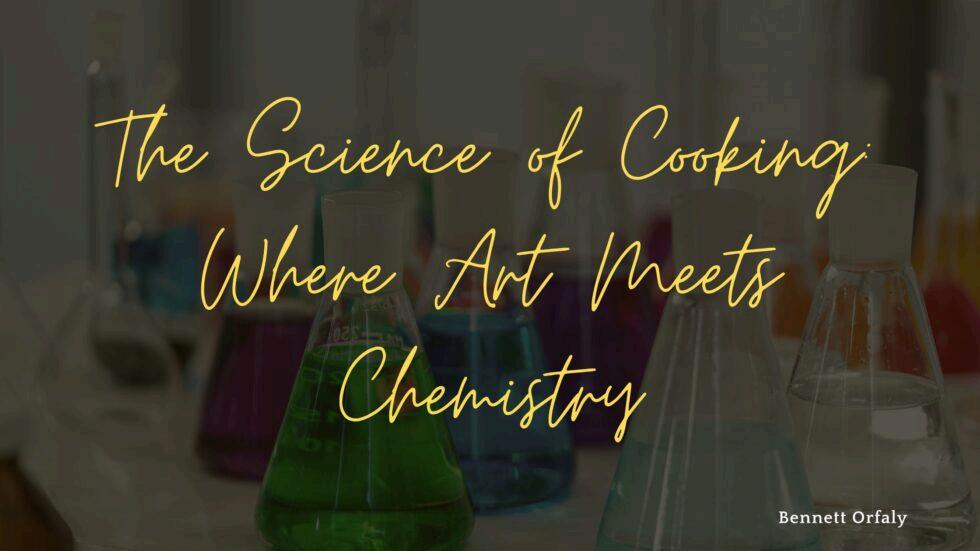The Science of Cooking: Where Art Meets Chemistry
by Bennett Orfaly | Nov 14, 2024 | Art, Art of Cooking, Bennett Orfaly

Cooking is often regarded as an art, but it is also a fascinating science. Understanding the scienti�c principles behind cooking can enhance culinary skills and lead to delicious outcomes. This blog explores the essential scienti�c concepts that every cook should know, from chemical reactions to temperature control, revealing how these elements contribute to the artistry of cooking.
The Maillard Reaction: The Heart of Flavor
One of the most important chemical reactions in cooking is the Maillard reaction. This complex process occurs when proteins and sugars in food react under heat, resulting in the browning of the food and the development of rich, complex �avors. This reaction is what gives grilled meats, roasted vegetables, and baked goods their desirable colors and aromas.
The Maillard reaction is not just about aesthetics; it fundamentally changes the �avor pro�le of food. For instance, when you sear a steak, you’re not just cooking it; you’re creating a crust that enhances its taste and texture. Understanding how to harness this reaction can elevate your cooking. For instance, to achieve optimal browning, cooks
should ensure that their cooking surfaces are adequately preheated and that they avoid overcrowding the pan, which can cause steam and inhibit the Maillard reaction.
Emulsi�cation: A Culinary Skill
Emulsi�cation is another critical scienti�c concept in cooking, particularly relevant when making sauces and dressings. An emulsion is a mixture of two liquids that typically don’t mix, such as oil and vinegar. Successful emulsi�cation results in a stable blend that can enhance �avors and textures in dishes.
There are two main types of emulsions: temporary and permanent. Temporary emulsions, like a simple vinaigrette, can separate over time and require re-mixing before serving. Permanent emulsions, such as mayonnaise, require the addition of an emulsi�er, like egg yolk, to stabilize the mixture. Understanding the science behind emulsi�cation can help cooks create smooth, creamy sauces that add depth to their dishes.
To achieve a successful emulsion, the key is to add the oil slowly to the other liquid while whisking vigorously. This technique helps to break the oil into tiny droplets, allowing it to blend seamlessly with the other ingredients. With practice, anyone can master the art of emulsi�cation and create delicious dressings and sauces.
The Role of Temperature: Control Is Key
Temperature plays a crucial role in cooking, a�ecting both �avor and texture. Di�erent cooking methods require di�erent temperatures, and understanding these variations can help cooks achieve the desired results. For example, boiling pasta requires a di�erent temperature than simmering a sauce or roasting vegetables.
When cooking proteins, knowing the right internal temperature is essential to ensure food safety and achieve the perfect doneness. A meat thermometer can be a handy tool in the kitchen to monitor these temperatures accurately. For instance, chicken should be cooked to an internal temperature of 165°F (75°C), while medium-rare beef is best at around 135°F (57°C). Understanding these temperatures allows cooks to serve perfectly cooked meals every time.
The Importance of Timing: Patience Pays O�
Cooking is as much about timing as it is about temperature. Each ingredient has its own cooking time, and understanding how long to cook each component can make a signi�cant di�erence in the �nal dish. For example, adding vegetables to a stir-fry at the right moment ensures they remain crisp and vibrant rather than becoming mushy.
Additionally, many cooking techniques bene�t from resting time. For instance, letting a roast rest after cooking allows the juices to redistribute, resulting in a more �avorful and tender piece of meat. This patience pays o�, leading to a superior dining experience.
Conclusion: Merging Art and Science
The intersection of art and science in cooking o�ers endless possibilities for creativity and innovation. By understanding the scienti�c principles behind cooking, chefs can make informed decisions that enhance the �avors, textures, and presentations of their dishes. The Maillard reaction, emulsi�cation, temperature control, and timing are just a few of the concepts that can transform an average dish into a culinary masterpiece.
Embracing the science of cooking empowers cooks to experiment and push the boundaries of their culinary artistry. Whether you’re a home cook or a professional chef, delving into the science of cooking can lead to a deeper understanding of your craft and ultimately result in more delicious meals.
Recent Posts
The Science of Cooking: Where Art Meets Chemistry Welcome!
Links
Bennett Orfaly on Strikingly
Bennett Orfaly on VocalMedia
Bennett Orfaly's Executive Chef Site
